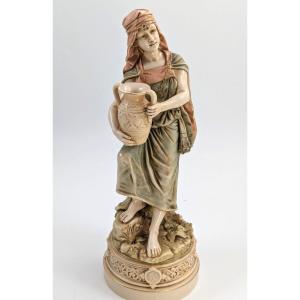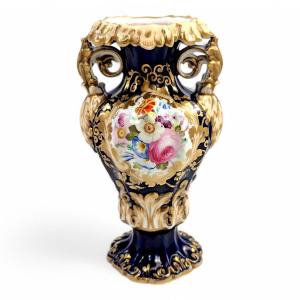In the centre, the painting depicts a maritime scene, with several ships sailing through stormy seas. The artist has captured the dynamic movement of the water with remarkable accuracy. The underside bears the official Minton stamp, along with a date mark confirming its period of creation.
Minton Porcelain Company was one of the pioneers of English porcelain production. The factory, established in 1793 in Stoke-on-Trent by Thomas Minton, became a major centre for producing high-quality ceramics, porcelain, and tiles in Victorian England, especially after his son took over in 1836. Minton became renowned for its cream-coloured and blue-printed earthenware, bone china, and Parian porcelain. The factory excelled in creating "art" porcelains during the Victorian era.
Located in Staffordshire, Minton was particularly known for its fine white bone china and bright colours. During the 19th century, Minton supplied large quantities of tableware, tiles, and other items to the USA. The White House, for instance, traditionally used Minton crockery, and many iconic buildings from the era, including the Houses of Parliament, were decorated with Minton tiles.
The Minton tableware also graces the dining room of the British Royal Family's yacht, "Britannia," where the most prominent figures from around the world have dined. Minton created special pieces for major exhibitions, starting with the Great Exhibition of 1851 in London, where they won a bronze medal for "beauty and originality of design." They went on to win a gold medal at the Exposition Universelle in 1855 in Paris. Queen Victoria herself purchased Parian pieces from Minton and gifted a dessert service to Emperor Franz Joseph of Austria.
The factory was a popular supplier of bespoke dinnerware for embassies and heads of state, and the Minton name continues to this day as part of the Waterford, Wedgwood, and Royal Doulton Group. The Minton trademark was one of the most famous porcelain brands of the 19th century and remains among the most expensive. It is a magnificent, exquisite gift and a true treasure for serious collectors.
Dimensions: Diameter 23.2 cm, weight 471 grams.
Condition: The paint, gilding, and enamel are all undamaged. There is a small, almost unnoticeable hairline crack on the back, which is not visible from the front. Otherwise, the plate is in excellent antique condition.
Please study the accompanying photographs carefully, as they form an integral part of this description. The item will be shipped with full tracking and insurance. Please note that shipping costs include labour, packaging, and postage.










































 Le Magazine de PROANTIC
Le Magazine de PROANTIC TRÉSORS Magazine
TRÉSORS Magazine Rivista Artiquariato
Rivista Artiquariato